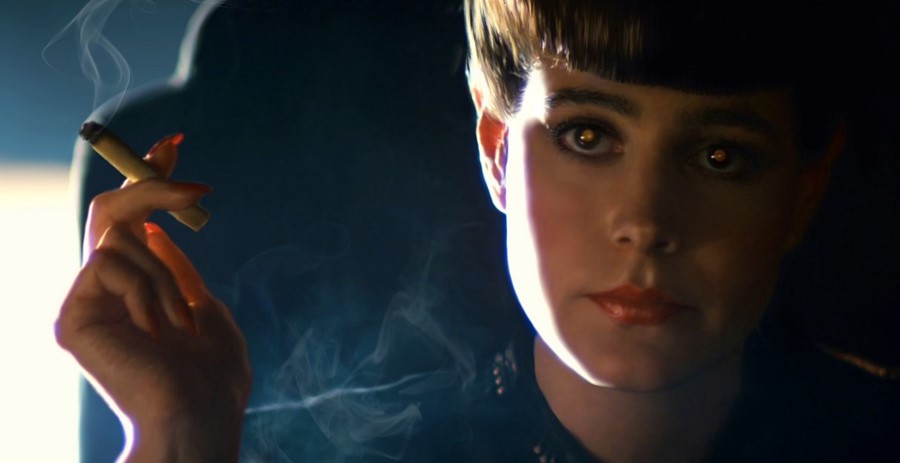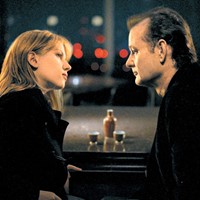The film’s characters and the corrupt city they live in are heavily inspired by Ridley Scott’s love of the dark, mid-20th century genre
In close competition with his 1979 epic Alien, Ridley Scott’s Blade Runner is perhaps the director’s most iconic, career-defining film. A grand, indulgent and densely layered feature which explores the murky underbelly of a futuristic, dystopian LA, the film owes much of its sombre philosophy and pitch-black aesthetic to 1930s and 40s film noir. Characterised by a pessimism which conspicuously pushed back against Hollywood’s rosy-hued grandeur, ‘film noir’ was first coined by french critics in 1946 to describe an emerging group of films which shared the same alienated antiheroes, rain slicked streets and seductive femme fatales.
Once great, now disaffected detectives like The Maltese Falcon’s Humphrey Bogart, and intriguing yet inscrutable sirens like Mary Astor informed Scott’s characters, whilst he moulded and evolved film noir’s obsession with deception and betrayal into a specific and growing distrust of multinational corporations. “I was drawn to the moral content, the idea of an officially sanctioned killer murdering what were, after all, really people, even if they were synthetically developed,” Scott told Empire in May last year. “(It) crossbred a noir film with a police story with science-fiction, and I could sense a lot of opportunities in that hybrid.” Noir was just the genre he needed to package his futurist vision of modernity, morality and mankind.
Though he could see the potential of this new sci-fi fusion however, it wasn’t a combination that Scott’s investors understood. “I said, ‘It’s called film noir,’ they said, ‘What's a film noir?’ That was a big problem,” he explained to editors at The Hollywood Reporter. The film wasn’t a financial success, but, despite its lukewarm box office reception, it was Scott’s enigmatic aesthetic that elevated and preserved Blade Runner as a cult classic. With the release of the eagerly anticipated sequel Blade Runner 2049 just around the corner, we spoke to Rhidian Davis, curator of the BFI’s Days Of Fear And Wonder and Ian Brookes, author of Film Noir: A Critical Introduction, to find out more about how film noir influenced the Blade Runner’s darkness and why it’s integral to the film’s lasting success.
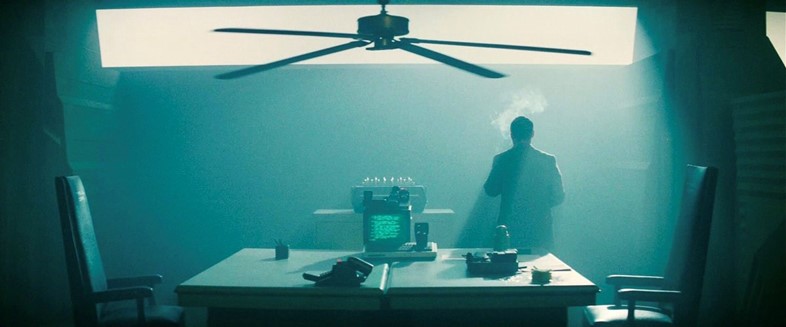
ON BLADE RUNNER’S STYLISTIC HERITAGE
Of all the tropes that define noir, its striking, sullen visual style is perhaps the most recognisable. Widescreen shots of an endless, decaying metropolis, crowded, dark and diseased with societal discord; high-contrast venetian blinds; people perennially smoking cigarettes and monsoon levels of rainfall are all elements that define the genre. “They were shot in a very dark way, often with dark, despairing and nihilistic stories,” says Brookes. “The visual style is central: low-key lighting, the use of darkness, urban settings, and so on.”
“People didn’t really think about the future as a decaying carcass of its own making before Blade Runner” – Rhidian Davis
But similarly it’s no ode to Depression-era whodunnits. Scott gazes into the future far more than he mirrors what’s gone before him. “You have a futuristic, science fiction genre spliced with an historical one, film noir,” says Brookes. “There are sometimes specific reworkings of some of the tropes from 1940s noir projected onto a future setting”. Davis agrees: “Ridley Scott brings an aerosol, neon palette to Blade Runner ... [the film] has rebooted, updated and colourised a lot of the tropes of film noir. It pushes the embryo of noir to give birth to something new. It takes noir into sci-fi in the same way Star Wars takes the epic, samurai adventure into sci-fi.”
Likewise, its LA setting references the past, while at the same time catapulting it into the future. “The production design features some quite specific nods to classic noir locations, such as the use of the Bradbury Building in Los Angeles for J. F. Sebastian’s apartment building,” says Brookes. According to Davis, “people didn’t really think about the future as a decaying carcass of its own making before Blade Runner.”
THE CHARACTER SIMILARITIES BETWEEN BLADE RUNNER AND NOIR
As well as the setting for his film, and the shots he used to frame it, visual similarities between Ridley’s protagonists and the noir characters of old are also remarkably strong. Trenchcoats, thick-padded blazers and hourglass silhouettes abound in both, as Brookes notes, “Rachael is certainly modelled on a 40s look – the veil, the pillbox hat, the shoulder pads, the mascara, the continual smoking – it’s classic 1940s noir.” Davis agrees: “She shares parallels with Lauren Bacall in The Big Sleep, with Joan Crawford in Mildred Pierce.”
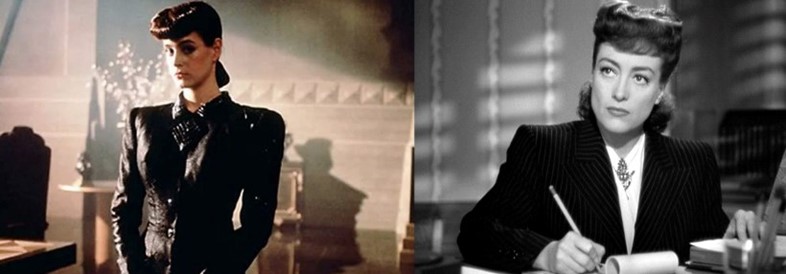
Deckard too, follows the format laid out in film noir, says Davis. “Harrison Ford is the quintessential private detective ... straight out of the 40s,” he says. “[He] is an outsider,” notes Brookes, “he seems to be on the margins, he’s on the street; but, at the same time, he’s clearly somebody who has, or had, real expertise in the field, in detective work. The idea of the burned out cop who got out of the force, there are obvious resonances with noir detectives there.”

Even more marginal parts, and specific episodes in the film hint at their noir heritage, “In the opening of Kiss Me Deadly, a woman, naked under a raincoat, flees barefoot headlong down an LA highway,” says Davis. “It’s not an exact match for Zhora, but there’s a strong kinship there.”
Just as with his cinematography, Scott uses his characters to modernise the genre, evolving it beyond its traditional form, “Roy Batty is the one figure you don’t easily find in noir” notes Davis. “He’s an extraordinary icarus figure who draws from the Romantic. He’s Frankenstein’s monster, he’s Oedipus. He’s straight out of a William Blake painting. He’s a flamboyant, romantic, terrorist dandy. Batty is the overdone Sydney Greenstreet to Harrison Ford’s underdone Humphrey Bogart.” Likewise, Brookes sees Batty’s musings on life, death and what it means to be human as something unique to the film, “Blade Runner ... asks a very philosophical question about what it means to be human and what control you have over your life.”

BLADE RUNNER’S CRITICISM OF CORPORATIONS
Perhaps the aspect that sees Scott realise this modernising impulse most fully is his relentless focus on ‘the corporation’. Tyrell, with his promise of “more human than human,” the persistent drive that accompanies this vision and the question of what distinguishes replicants from those that ‘retire’ them takes centre stage in Blade Runner. When technology companies pursue consumer convenience at greater and greater moral cost, who is left to police their business practices? “Scott is less concerned with questions about technology, he’s more interested in the reproduction of mythology,” says Davis. “Technology becomes a mask for our spiritual redundancy.”
“Scott is more interested in the reproduction of mythology. Technology becomes a mask for our spiritual redundancy” – Rhidian Davis
Brookes goes a step further. “With Blade Runner, straightaway you’re introduced to the Tyrell Corporation, we see the building looming large, towering over the city … What it does – in a way that film noir couldn’t because there was no real ecology movement at that time – is to critique these corporations at least partially from a green perspective. It highlights a deregulated world where everything is synthetic, overcrowded. Animals have become endangered or extinct, and now exist only as exotic, manufactured copies.
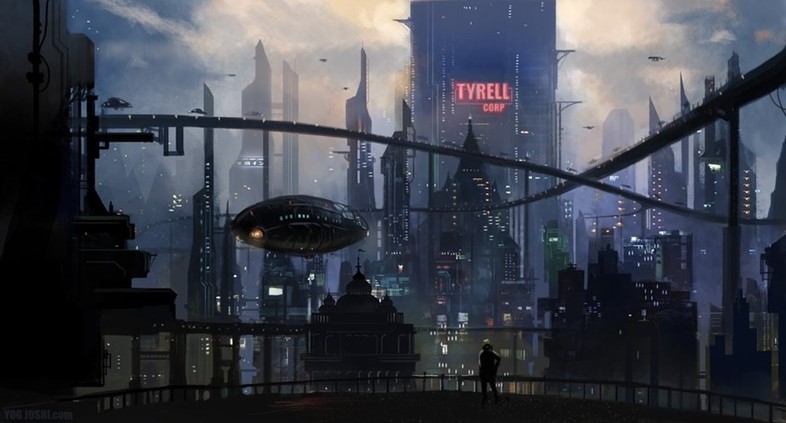
It’s a futuristic city that’s gone wrong, it’s all smog and rain – even the weather has gone wrong. The parallels with today are unmistakable so it’s very prescient in that depiction. It’s taking a strand from 40s noir – its corrupt corporate world – and adapting it for today, when everything is getting out of control. The replicants – ‘skin jobs’ – are effectively slaves produced by the corporation, different models designed to do different work. Pris, for example, is a ‘basic pleasure model’ – a kind of cyborgian punk sex doll. Zhora is similarly sexualised and fetishised, accessorised with a fake snake…Look at what’s happening today with the idea of female sex dolls – and that’s a good example of the reworking of a noir trope to reflect a contemporary concern.
Blade Runner 2049 arrives in cinemas nationwide on 4th October.
